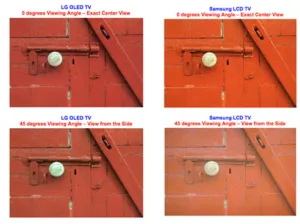When I wandered into the Exhibit Hall at the Moscone Convention Center West, the first visible display was LG’s 77” HDR UHD AMOLED TV, which was attracting the most interest and largest crowds on the floor and subsequently received SID’s best in Show Award. It was truly spectacular, but I am quite biased.

Notwithstanding the performance and the award, QD Vision and Nanosys (who, by the way, are entangled in a vicious patent suit, each claiming ownership of quantum dot (QD) IP) made very questionable statements at both the Business and the Investor’s Conference about how OLED TVs were outperformed by LCD’s with QD enhanced LED backlights (QD LCDs). Both Seth Coe, QD Vision founder and CTO and Jason Hartlove, Nanosys CEO, a relative neophyte in the display industry, lectured us that the only attributes which counted when a consumer buys a TV is how wide the color area and how bright the display is at maximum level. By observation or by market perception, they don’t think that contrast ratio, black levels, viewing angle, response time, color accuracy, or form factor enter into the buying equation.
If we were to accept their premise, QD LCDs would clearly be the TV of choice. Moreover, we wonder what DisplayMate and virtually every display critic and several movie directors could be thinking when they compare OLEDs with QD LCDs and conclude that the OLEDs are the best TVs they have ever seen. Even LED advocate, financial analyst and OLED critic, Canaccord Genuity’s Jed Dorsheimer has purchased a 55” AMOLED TV and says he loves it.
So what is happening when respected media personalities and Display Daily contributors, current and former publishers Bob Raikes and Chris Chinnock, respectively, reprise the claims of the QD folks and question the viability of AMOLED TVs? Are they simply drinking the QD “Kool-aid” or do they know something not quite apparent to the rest of us?
QDs are amazing inventions that improve on the color performance of blue LEDs used with yellow phosphors to produce white light. The narrow spectrum helps QD LCDs deliver a much-improved image that will soon offer REC 2020 color width. In addition, the color sharpness does give the TV the appearance of higher contrast, although no measurements documenting the improvement have been provided. And there is no doubt that QD LCDs have significantly lower prices than comparable AMOLED TVs.
Nanosys said that OLEDs don’t do HDR, but when presented with the obvious existence of LG’s 77” AMOLED display with HDR, Hartlove backtracked and said “well it doesn’t meet the spec”. Of course, one of the points that IHS’s TV guru and moderator, Paul Gagnon, so eloquently made during the Business Conference was that HDR was so new and there were so many players, no spec has been widely accepted. Granted LG’s AMOLED had maximum luminance of ~5-600 cd/m² and some would like it to be >1,000 cd/m²; but it is also their first HDR version and LG has plans for higher brightness. We could not make a meaningful comparison since there wasn’t an HDR QD LCD TV available for comparison.
So how does this observer view the situation of QD LCDs vs. AMOLEDs? First, the main advantage of QDs is the perceived improvement of LCD TVs and how they are reducing the difference in performance vs. AMOLEDs. But the claims that QD LCDs have wider color width than OLEDs are just not true. Last year, DisplayMate compared the best Samsung QD LCD with LG’s AMOLED and found the color area to be virtually the same, except that the AMOLEDs were a bit wider. No more recent third party evaluation has been published to date.
Color area for OLEDs is a matter of the percentage of red, green, & blue emitter vs. host material and that becomes a design tradeoff with efficacy, lifetime, color saturation and quenching limits. Unlike LCDs, OLED material is in the very early stages of development and continues to improve by 15% to 20% each year as documented by DisplayMate. So it is likely that over time, each technology will claim the widest color area at different times.
From the buyer’s perspective, the slight difference would be impossible to recognize. As to luminance, LG already offers HDR and they will increase the cd/m² as necessary. LG uses very effective circuits from Ignis Innovation¹ to compensate for the aging of the OLEDs at very high luminance levels and that allows them to go to much higher nits without damaging the device. Moreover, OLEDs will continue to have advantages in contrast, color accuracy, black levels, viewing angle, response time and form factor. For an example of the LCD performance at wide viewing angles, see below for DisplayMate’s comparison on viewing angles. If you want a more current example, you needed to go to the QD Vision booth at the SID DisplayWeek, where an older OLED TV was compared with a standard phosphor-based LCD and two QD LCD TVs. Even in this biased condition, the LCDs show greater color shift and contrast loss at wide viewing angles.
The high end of the TV market, per IHS, is around 40m out of 250m units and QD LCDs are expected to ship 5m in 2016 and capture 18m by 2020, which would limit OLED TV penetration as long as the price premium is greater than ~10% to 20%. Currently there is a 2-4x difference in price depending on size, resolution and features. OLEDs will never capture a significant market share unless prices can be driven down to near LCD levels.
LG is the only panel maker producing OLED TVs and their cumulative yields for 55” and 65” TVs are around 50% when the capacity is compared to actual sales. It is noteworthy that Samsung recently opted out of OLED TV production until the cost reaches near LCD levels (don’t believe the garbage about QLEDs in 2019.) To reach cost parity with LCDs, LG must bring down the costs by ~75%. Improving the current yield from 50% to 85% (LCDs are around 90%) would reduce the cost by 70%.
The other big cost reduction target is organic material, which contributes ~$150 for a 55” display due, in large part, to the low material utilization in the Vacuum Thermal Evaporation (VTE) process which deposits organic material on the substrate without a fine metal mask (FMM). Were this process to be replaced by IJP and soluble material, which Conor Madigan, Kateeva founder and President, says could happen within two years, the material cost would be reduced by 2/3, lowering overall costs by another 20% after the yield improvements. (Kateeva is actually working with Samsung Display to test IJP w/soluble material.)
These two changes should make OLED TVs cost competitive, just when QD LCDs are hitting their stride. If the OLED cost down process works there would be no market for QD backlights in high end TVs, where the profits are. Without the cost down targets, QD backlights in TVs will thrive. As a hedge, QD proponents might consider the 40” and under TVs and monitors, where OLEDs are unlikely to tread for some time. Long term – electroluminescent QDs, which are currently struggling with low lifetimes and micro LEDs, which need efficient pick and place solutions, may be viable. But OLEDs will also improve and the display graveyard is jam-packed with venture capital, private equity, good intentions and what appear initially to be great ideas. – Barry Young
Figure 1 Comparison of Viewing OLED and QD LCD TVs at 0° and 45° Source: DisplayMate
Barry Young is the Managing Director of the OLED Association and is on the board of Ignis Innovations. He was an SVP at DisplaySearch from 1995 to 2007.

